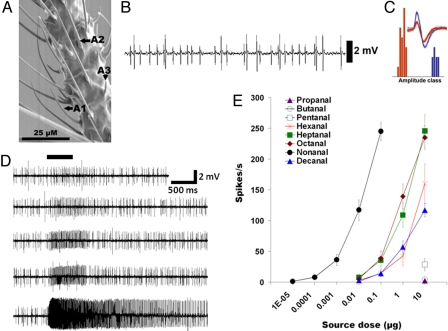Fig. 4.
Cx. quinquefasciatus antenna, sensilla, and ORNs detecting nonanal, the key constituent of host odors. (A) A scanning electron micrograph of the 12th antennal segment showing three distinct classes of sensilla (named after ref. 5): thin sharp tipped (A1), thick blunt tipped sensilla (A2), and grooved pegs (A3), the shortest sensilla. (B) A2 type houses two ORNs with distinct spontaneous firing rates and amplitudes revealed by extracellular single-unit recordings. (C) Amplitude-frequency histograms with an inset showing two distinct neuronal spike clusters (blue and red). (D) Neurons of large amplitude responded to nonanal with extreme sensitivity. Excitatory neuronal response elicited by increasing dose of nonanal: 0.001 to 100 ng in decadic steps (top to bottom). (E) Dose-response curves for a homologous series of aldehydes, C3-C10 (n = 9–13 ± SEM).

